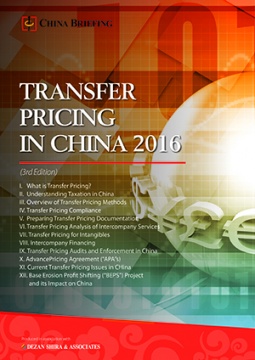China Increasingly Sophisticated in Handling of Transfer Pricing Audits
Feb. 19 – China’s State Administration of Taxation has been developing and implementing growing resources on transfer pricing audits, both in terms of increasing personnel in charge of audits, and improving audit practices by issuing a number of tax circulars starting in 2007 to address specific issues related to transfer pricing.
Recently, instead of focusing on transactions using traditions methods such as comparable controlled price, cost plus or resale price, more transfer pricing audits have been focusing on intangibles and the preference for the profit split method over traditional methods according to a recent Ernst & Young report.
This is believed to be due to two factors:
- China’s changing status from being only a low cost factory for the world to also supporting one of the fastest growing consumer markets; as companies restructure their China investment to take advantage of the growing demand inside the country, the changes required have brought about significant intangibles such as trade names and marketing issues not previously faced in China
- A US$3.4 billion tax settlement reached between GlaxoSmithKline, the London-based pharmaceutical giant, and the U.S. Internal Revenue Service that has provided further precedence for SAT inquiries into marketing intangibles; the SAT has been evaluating the facts of the Glaxo case for further use in its own transfer pricing audits in China
This intensification by the SAT on related party transactions and some more non-traditional methods to evaluate them shows the growing sophistication and worldliness that the SAT has been able to achieve in a relatively short span. With an increased burden on compliance and stricter penalties in place, it is important that enterprises involved in any aspect of transfer pricing maintain their transfer pricing documentation and keep themselves completely updated on all tax requirements.
For more information on transfer pricing methods, audits and documentation requirements, please contact Dezan Shira & Associates at tax@dezshira.com.
![]()
 Transfer Pricing in China 2016
Transfer Pricing in China 2016
Transfer Pricing in China 2016, written by Sowmya Varadharajan in collaboration with Dezan Shira & Associates and Asia Briefing, explains how transfer pricing functions in China. It examines the various transfer pricing methods that are available to foreign companies operating in the country, highlights key compliance issues, and details transfer pricing problems that arise from intercompany services, intercompany royalties and intercompany financing.
 Annual Audit and Compliance in China 2016
Annual Audit and Compliance in China 2016
In this issue of China Briefing, we provide a comprehensive analysis of the various annual compliance procedures that foreign invested enterprises in China will have to follow, including wholly-foreign owned enterprises, joint ventures, foreign-invested commercial enterprises, and representative offices. We include a step-by-step guide to these procedures, list out the annual compliance timeline, detail the latest changes to China’s standards, and finally explain why China’s audit should be started as early as possible.
Managing Your Accounting and Bookkeeping in China
In this issue of China Briefing, we discuss the difference between the International Financial Reporting Standards, and the accounting standards mandated by China’s Ministry of Finance. We also pay special attention to the role of foreign currency in accounting, both in remitting funds, and conversion. In an interview with Jenny Liao, Dezan Shira & Associates’ Senior Manager of Corporate Accounting Services in Shanghai, we outline some of the pros and cons of outsourcing one’s accounting function.
- Previous Article Online Filing of Profits Tax Return in Hong Kong
- Next Article Revised Regulations on Audit Laws Released










